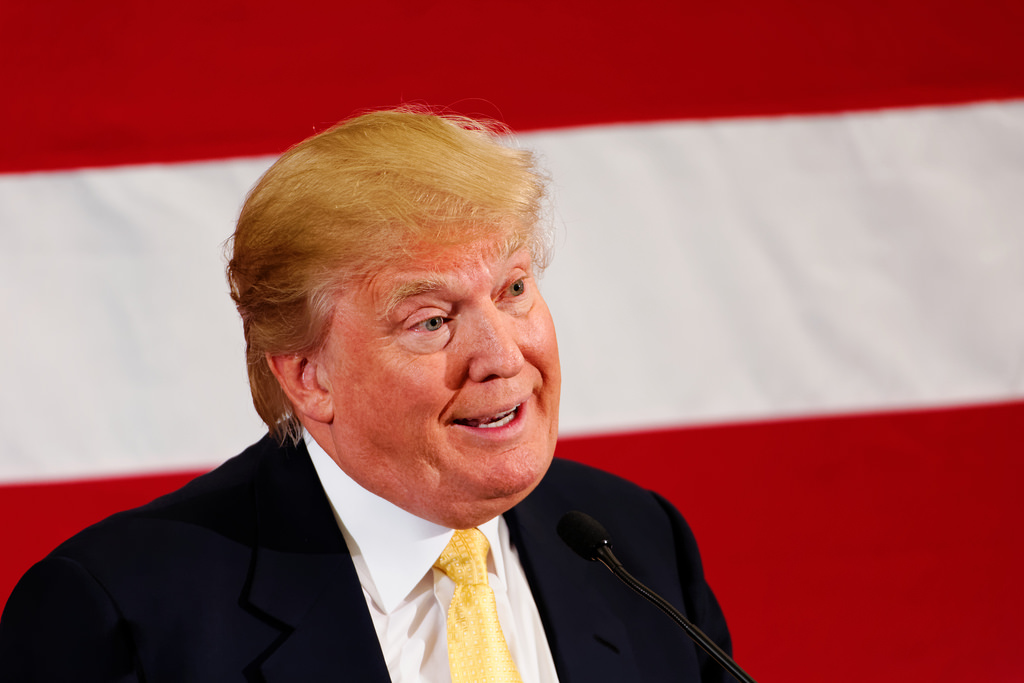Donald Trump’s tax plan has been criticised for lack of detail and as a $US1.5 trillion bet on trickle down economics which is overwhelmingly skewed in favour of the rich. Pulitzer Prize winning journalist, Trump biographer and multinational tax avoidance expert, David Cay Johnston, looks at it from a business and accounting point of view and evaluates the winners and the losers. Johnston is in Australia next week for the Sydney University’s Dark Money project, a collaboration between <ahref=”http://sydney.edu.au/arts/sdn/”>Sydney Democracy Network and michaelwest.com.au.
DONALD TRUMP’S 100-word proposal on taxes, which would slash by 57 per cent the rate at which business profits are levied, seems like it would be a boon to business.
It would be for some as their tax rate falls to 15 per cent from 35 per cent. But that sharp drop, which would have devastating consequences for some firms, would also increase the federal debt that candidate Trump vowed to reduce.
For some companies the Trump tax plan, vague as it is, would mean the loss of more than half of their tax assets.
You may find the phrase “tax assets” jarring. Taxes are usually thought of as a liability, a cost. But the corporate income tax can be an asset – even a source of profit – thanks to two factors.
Smart @tamarakeithNPR on Trump "We'll see what happens" phrase (quotes me). https://t.co/DOriOTgx3L
— David Cay Johnston (@DavidCayJ) October 21, 2017
One is modern accrual accounting that tracks economic activity, not just when cash changes hands. When a car comes off the assembly line and is driven to a staging lot, Ford books it as revenue even though months may pass before a dealer sells the vehicle.
Based on decades of experience, Ford accountants know the likely future receipts from that car. And when they are wrong, and the car gets sold at a premium or sent to a crushing machine, they adjust the accrued revenue.
The other factor is federal law. Congress requires companies to keep two sets of books, one for shareholders and another for the tax man.
The differences between book and tax accounting create opportunities and threats.
Companies with big capital spending on long-term assets like factories and buildings get to depreciate them faster for tax purposes than for shareholder records. The difference between these two can be enormous. Money not paid in profits taxes this year – but instead paid years, or even decades, in the future – is the equivalent of a zero-interest loan from Uncle Sam.
Think about how rich you would be if you paid, say, 10 per cent of your income tax bill this year and got to keep the rest as a zero-interest loan for the next three decades. Invested wisely, the proceeds of that zero-interest loan would make you rich even when you eventually pay the taxes, using dollars whose value has been eroded by inflation.
Multinational companies get to expand on this by shifting profits from their American books to those of offshore subsidiaries. It’s as if you moved a dollar in your left pocket to your right and got a tax deduction – and a zero-interest loan of that dollar – until you put it back in the left pocket. (For more, see What If You Were Taxed Like a Multinational?)
Companies like Apple, with more than a quarter of a trillion dollars in cash overseas – note that “t”– would get a huge benefit. Money siphoned out of the U.S. to avoid a 35 per cent tax could be brought back at a 15 per cent tax rate.
Of course, Congress could require companies to settle up at the rate of tax avoided but the odds on that are about the same as Vladimir Putin holding free elections in Russia.
Keep in mind that this fiscal year the U.S. corporate income tax is expected to raise about $US428 billion. That’s a bit more than 2 per cent of the Gross Domestic Product. Even if those revenues were cut 57 per cent, the $US180 billion in tax savings for businesses would come to just a penny on each dollar of economic output, not enough to spur the kind of economic growth needed to make up for the revenue loss.
The written Trump statement said nothing about sole proprietors, but Trump aides later said they would include so-called Schedule C businesses in the 15 per cent tax-rate plan.
That tax rate would be great for everyone with a successful business, including me, as the income taxes on our self-employment profits would fall from as much as 39.6 per cent to 15 per cent. But only five million out of 18.3 million profitable sole proprietorships would benefit from the lower rate, my analysis of IRS Table 1.4 for 2014, the latest full data available, shows.
Almost 72 per cent of the country’s sole proprietors made less than $US75,000, meaning they were already taxed at 15 per cen or less.
Smart @ThePlumLineGS piece (quotes me) on Trump's latest bizarre & know-nothing estate tax position. https://t.co/rfA7VC2aIV
— David Cay Johnston (@DavidCayJ) October 11, 2017
This would also be unfair to employees who make the same pay. Why should someone with a $US500,000 profit from self-employment pay a federal income tax rate of 15 per cent while an employee paid exactly the same sum would face a marginal tax rate of 35 per cent with Trump’s plan.
Now let’s turn from winners (and those who are unaffected) to losers under the vague Trump proposal.
The corporate parents of major banks would be among the biggest losers were Congress to cut the corporate tax rate by 20 percentage points.
Citigroup, which owns Citibank, has $US45.4 billion in deferred tax assets. Their value as offsets to future profits would fall to about $US26 billion if the future tax rate is lowered, though for complex technical reasons the actual loss may be closer to $US24 billion.
Trump might even be a loser if he has any net operating losses or NOLs from past years to take against future profits. Without access to his tax returns we cannot tell how much he will benefit from any changes in federal tax law.
The Trump administration touts corporate tax-rate cuts as a way to juice the economy and push growth up to 4 per cent annually. That kind of growth is fantasy, as many serious economists with widely varying political perspectives have noted in recent months.
Decades of experience have shown that lower income tax rates don’t grow the economy, especially when public-sector spending that builds commonwealth is restricted.
For those companies that defer their taxes, the higher the tax rate the bigger the zero-interest loans these companies can engineer for themselves. Cutting tax rates reduces their source of no-cost capital.
Furthermore, corporate profits have been growing robustly even with current tax rates and their complex rules.
Corporate profits before tax, adjusted for inflation, doubled from 2000 to 2016, up from less than $US1.1 trillion to almost $US2.2 trillion last year.
Economic output per American rose 16 per cent more than inflation, but incomes reported on tax returns hardly budged. The latest data is from 2014, up just 3.2 per cent per taxpayer household from 2000, nowhere near the growth in profits or the economy.
This suggests that America has an income problem less with robust corporate profits or overall growth and more with anemic growth in individual incomes.
Curiously, wage growth in this country stalled for all but those near the top from 2001 through 2012, when the George W. Bush tax cuts were in full effect.
In 2013, when the top individual tax rate rose from 35 per cent to 39.6 per cent, wages paid to the bottom 75 per cent of workers rose. The next year, when the Affordable Care Act added additional taxes on highly paid workers and on major investors, wage growth increased more – and, as I reported last fall, it accelerated much more in 2015. In 2014 the median wage – half make more, half less – stood just six dollars higher than in 2000. Then it jumped by almost $US1,100 in 2015.
Cutting corporate tax rates, especially without complex adjustments for those firms with deferred tax assets and those with deferred tax liabilities, will do nothing significant to improve the economy. But it will do a lot to make the complex mess that is our tax system even more of a mess.
Smoke & Mirrors: the systemic campaign of multinational tax secrecy

David Cay Johnston
David Cay Johnston is the recipient of the Pulitzer Prize, an IRE Medal and the George Polk Award. He is editor and founder of DCReport.org, a news website that reports on the Trump administration, and author of The Making of Donald Trump, Political Biography of the Year (Britain), and The Trump Factor: How He’s Making Things Worse for Most of Us (forthcoming 2018).
He is a specialist in economics and tax issues, and teaches business regulation, property and tax law at Syracuse University’s law and graduate business schools. In March 2017, he famously released a portion of President Donald Trump’s 2005 tax return. The Washington Monthly describes him as “one of America’s most important journalists.”
David Cay Johnston’s latest book, “The Making of Donald Trump,” was published on August 2, 2016. His next one will be “The Prosperity Tax: A New Federal Tax Code for the 21st Century Economy.” Johnston is a Distinguished Visiting Lecturer at Syracuse University College of Law and Whitman School of Management, and also writes for The Daily Beast and Tax Notes. You can follow David on Twitter @DavidCayJ.
This article was originally published in The Daily Beast and is republished with permission.
Who "disclosed" 2005 Trump tax form? A) MSNBC per @NYTimes or B) https://t.co/1dBN5xvCfB & me as @maddow said? Tell [email protected] pic.twitter.com/R5xWjcGJat
— David Cay Johnston (@DavidCayJ) March 24, 2017
DCReport’s founder and editor is Pulitzer Prize-winning journalist David Cay Johnston, author of seven books including ‘The Making of Donald Trump’ and ‘It’s Even Worse Than You Think: What the Trump Administration is Doing to America’. His reporting persuaded two presidents to change their tax policies, stopped tax dodges that Congress valued at more than $250 billion in the first decade alone, and promoted the passage of many federal and state laws and regulations. The Washington Monthly calls David “one of America’s most important journalists.”

